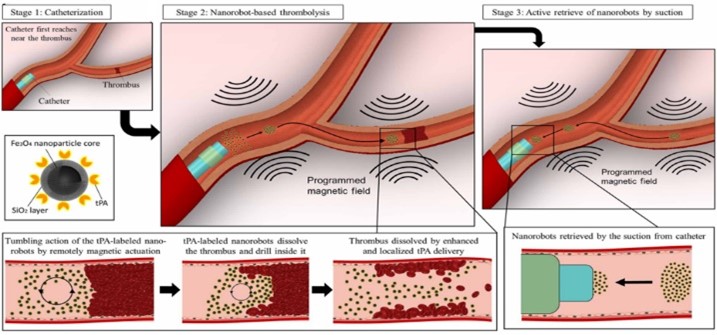A research team led by Professor Zhang Li of the Faculty of Engineering and Professor Thomas Leung Wai-hong, Professor Simon Yu Chun-ho, Professor Bonaventure Ip Yiu-Ming, and Professor Tony Chan Kai-fung of the Faculty of Medicine of The Chinese University of Hong Kong (CUHK) have collaboratively developed tPA-modified magnetic nanorobots (tPA-nanorobots) that can achieve rapid elimination of blood clots for stroke treatment. Moreover, in vivo real-time tracking and navigation of tPA-nanorobots in the endovascular system was achieved by using laser speckle contrast imaging (LSCI), allowing us to explore the interactions between the tPA-nanorobots and blood clots. The collaborative research was recently published in the internationally renowned journals Science Advances and Science Robotics.
Challenges for clinical ischemic stroke treatment
Stroke is the second cause of death worldwide, and caused more than 5.7 million deaths in 2016. Clinically, administering drug-tissue plasminogen activator (tPA) for dissolving blood clots is one of the main treatment methods. However, concerns have been raised about a significant mortality rate observed within seven days of treatment. This is attributed to the potential risk of symptomatic intracranial haemorrhages (SIH) due to the unrestricted spread of high-dose injected tPA. However, accurately predicting the SIH during thrombolysis remains elusive, instilling fear in clinicians and patients. Hence, the pressing challenge in thrombolysis lies in achieving rapid recanalization (reopening a previously occluded passageway within a blood vessel) using minimal doses of tPA while minimising adverse effects.
Fast recanalization by tPA-nanorobots with ultra-low dose and retrieval ability
In this study, researchers have developed a novel approach, using retrievable magnetic tPA-nanorobots to enhance thrombolysis while administering an ultra-low dose of tPA with the assistance of a catheter. Compared with traditional treatment, this novel technology improves the thrombolysis rate by 5 to 20 times, especially in recanalising more distal and smaller branches.
Professor Zhang Li, of the Department of Mechanical and Automation Engineering, explained, “The size of tPA-nanorobots (~300 nm) allows them to be navigated to the thrombus site within the narrow distal blood vessels. The enhanced, localised delivery can prevent high-dose tPA from being circulated in the body, reducing the possibility of systemic and brain haemorrhages. Even with the reduced dosage, the tPA-nanorobots with both mechanical and chemical etching exhibit a thrombolysis rate 5 to 20 times faster than traditional treatment and save abundant recanalisation time, potentially saving patients from heavy brain damage.”
Professor Thomas Leung Wai-hong, of the Division of Neurology, Department of Medicine and Therapeutics, CUHK, commented, “Without treatment, brain cells die at an alarming rate of 1.9 million every minute from stroke onset. While we can now access the main stem of the brain arteries and remove the occlusive clots through catheters, the technological bottleneck is recanalising more distal and smaller branches that are equally vital in preserving brain function. One key challenge is how we can accomplish this goal in a safe and effective manner.”
Professor Simon Yu Chun-ho, of the Department of Imaging and Interventional Radiology, CUHK, commented, “This novel treatment system can potentially deploy nanorobots to the exact location of the thrombus in peripheral and small arteries, which are hardly accessible with catheters alone. Although many technical issues remain to be solved before this technology can be applied in clinical practice, I believe we have taken an important step in the right direction.”
Professor Bonaventure Ip Yiu-Ming, of the Department of Medicine and Therapeutics, CUHK, commented, “Real-time monitoring of the behaviour of nanorobots under physiological conditions is a crucial step to prove their safety and effective delivery. By employing LSCI, we were able to observe and track the movement of nanorobots in both stagnant and flowing blood environments in vessel models, placenta and small animals. This visualisation marks a critical milestone in refining the dose of nanorobots and the distance, strength and angulation of the magnetic field applied. It is essential to carefully optimise these parameters before implementing the technology in humans.”
Tony Chan Kai-fung, Research Assistant Professor of the Chow Yuk Ho Technology Centre for Innovative Medicine, added, “The proposed tPA-nanorobots with high spatial precision provide a promising robotic tool to enhance thrombolysis efficiency and safety, while side effects and treatment time are greatly reduced. It shows the great potential for clinical translation.”
The team envisions that the proposed tPA-nanorobots with high spatial precision can provide a promising robotic tool to achieve enhanced thrombolysis efficiency for rapid recanalization, while side effects and treatment time are greatly minimised, showing great potential for translation into clinical applications.
Acknowledgement
This work is supported by the Research Grants Council (RGC), the Innovation and Technology Commission (ITC), the Multi-scale Medical Robotics Center, the Chow Yuk Ho Technology Centre for Innovative Medicine, CUHK-SIAT Joint Research Laboratory on Robotics and Intelligent Systems, and CUHK T Stone Robotics Institute.
Fig.1. Photo of magnetic actuation system combined with fluoroscopy imaging modality. Fig.2 Conceptual drawing of the fluoroscopy-guided delivery of tPA-nanorobots for targeted thrombolysis and in situ tPA-nanorobots retrieval using a catheter-assisted magnetic actuation system. Fig.2 Conceptual drawing of the fluoroscopy-guided delivery of tPA-nanorobots for targeted thrombolysis and in situ tPA-nanorobots retrieval using a catheter-assisted magnetic actuation system. Fig. 3. Professor Zhang Li (first row, first right), Professor Tony Chan Kai-fung (second row, second right) and the research team. Fig. 3. Professor Zhang Li (first row, first right), Professor Tony Chan Kai-fung (second row, second right) and the research team.
|
